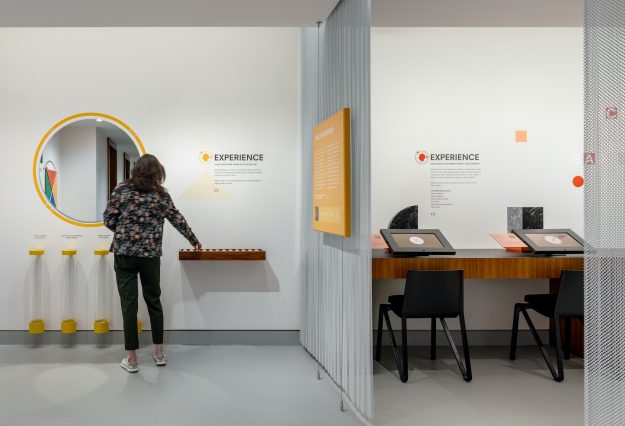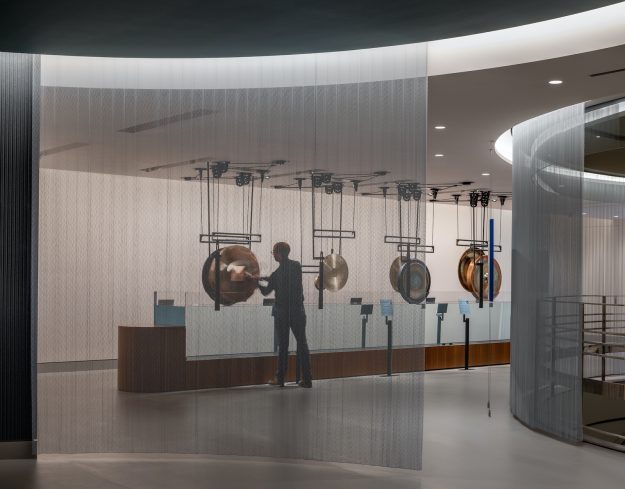The newly opened Mandala Lab at the Rubin Museum of Art in New York’s Chelsea neighborhood looks at the power of difficult emotions and their potential to transform while fostering a more informed way of seeing ourselves and the world with greater clarity.
The exhibit draws from the Buddhist practice of using mandalas as visual tools for working through the emotions of pride, attachment, envy, anger, and ignorance—also known as kleshas. As Tenzin Gelek, the Rubin’s senior Specialist of Himalayan arts and culture, noted in the exhibit handouts, “In Buddhism the five kleshas are the key afflictive emotional responses that are the root cause of our suffering.” Practitioners, with the help of their teachers, find ways to transmute these feelings as a means to navigate the inevitable trials faced in a given lifetime.
Divided into quadrants—north, south, east, and west—the interactive space, located on the museum’s third floor, takes its inspiration from the Tibetan Buddhist Sarvavid Vairochana Mandala. The Sanskrit word mandala means “extracting a meaningful essence.” Using interactive artworks and experiences, the museum created what Gelek describes as a “mental gym” in order to “understand, unlock, and heal these difficult emotions within ourselves.”
The Rubin’s signature spiral staircase acts as the mandala’s center. Visitors’ first encounter with the installation happens in the south quadrant, where they are greeted with a pointed question: “How does pride show up in your life?” The question is meant to encourage visitors to consider how they view themselves and others as “a first step toward the wisdom of equanimity, which is an abandonment of judgment.” There is an option to choose which statement about pride most resonates by placing a token in the corresponding slot. On this particular day, slots with the most tokens were, “I think I am better than others” and “I think I am worse than others.”

The “Scent Library” in the west quadrant investigates attachment through the sense of smell. Six kiosks in the library display a scent selected by a contemporary artist and created by master perfumer Christophe Laudamiel. The artists produced short videos inspired by these same aromas that explore how memory and emotions are intertwined. Musician and performance artist Laurie Anderson talks about the smell of smoke from her Uncle Allen’s cigarettes while writer Amit Dutta reflects on the scent of the earth through a whimsical stop motion animated video.
For filmmaker Tenzin Tsetan Choklay, the son of refugees who fled Tibet in 1959, it was the smell of fresh laundry that reminded him of his childhood in Dharamsala and his mother’s final days before dying of cancer. While Choklay and his family members are spread throughout the globe, he was able to work through his understanding of impermanence, attachment, and his mother’s death while rekindling familial relationships when he was making his short film “1994,” featured in Scent Lab. “I feel like it gave a good closure to one of the stories from our family’s past,” he said in the museum’s audio tour.
For me the highlight of the lab is the commissioned sculpture by New York-based artist Palden Weinreb found in the north quadrant. The circular, multi-tiered work of resin and LED lights is the focal point for what the museum describes as a “Breathing Alcove” and was specifically designed for the space. Here visitors focus on the concept of envy using breath awareness—synchronizing the breath with a timed, pulsating light. The use of light as a guiding prompt will not be lost on both longtime and beginner meditators. Watching and breathing in tandem with the light as it cycles through the sculpture lulls you onto an unexpected pathway of interconnectedness and tranquility. “Can you breathe out envy and breathe in joy and appreciation?” asks the museum’s placard.
That inner tranquility is short-lived, however, as the installation takes a surprising and cacophonous turn with the neighboring “gong orchestra” in the east quadrant. As a self-described gong enthusiast, I was thrilled to see eight gongs of different sizes and metals chosen by established artists such as Peter Gabriel, Sheila E., Shivamani, and Sarah Hennies. All are suspended from the ceiling, hanging over a long basin of water. Visitors are prompted to channel their anger by sharply striking the gong and lowering the instrument into the water. As the gong is immersed, ripples form and then dissipate. “Keep the gong in the water until you can see your reflection and the fully calm surface,” says the museum audio tour. “Perhaps you’ve just experienced the wisdom of patience in the face of anger.”

I appreciate the intent behind the use of a gong as a tool to transmute anger—especially given the current state of the world. But I’m wary of taking such an aggressive approach to an instrument of this kind. Besides that, the sound of crashing gongs reverberating throughout the five floors of a museum known for its serene atmosphere is not without its drawbacks. One visitor was observed with tissue in her ears as she made her way through the exhibit.
Time will tell if the “gong orchestra” remains a permanent feature of the Mandala Lab. The museum views this 2,700-square-foot interactive space as “one of the city’s first cultural healing spaces in the aftermath of 2020,” according to Executive Director Jorrit Britschgi. In the coming months and years it will also function as the home for the Rubin’s School and Family Programs, introducing younger generations to the world of Himalayan art through social, emotional, and ethical learning (SEE Learning)—a program developed in partnership with Emory University.
As visitors complete their circumambulation around the Mandala Lab, they are asked to reflect on what they have learned and reminded that “we don’t know what we don’t know.” What we do know is emotions like anger, pride, envy, attachment, and ignorance are complicated and in a constant state of flux. The installation is effective in giving us creative tools to unpack them—cultivating the Buddhist principles of self-awareness and awareness of others. It’s through understanding these thorny emotions that we hope to one day overcome our ignorance—bringing ourselves to a place of greater wisdom and equanimity. In doing so, we continue to turn the wheel of dharma.